Last updated: November 9, 2023
Article
The Current: Fall 2023

NPS/T. Gostomski
A Time of Change and Growth for the I&M Division
It began with the Conservation Initiative. In 2019, then-IMD (Inventory and Monitoring Division) Lead Kirsten Gallo invited all I&M staff in a series of in-person, facilitated meetings to explore what the next 20 years of inventory and monitoring might look like, to come up with an audacious goal for us to reach in that time, and to track our success in working towards that goal by documenting “2,040 science-based solutions by 2040.” You may recall reading about this in the Fall 2019 issue of The Current.The Conservation Initiative had us all thinking about where I&M might be headed over the next 20 years. But then, like what happened to a lot of things that started taking shape in late 2019 and early 2020, COVID hit and we lost some momentum. Then Kirsten Gallo retired, and it was early 2022 before Meg White was hired to replace her. Now, with Meg at the helm, momentum is returning, but work and life are different than they were in late 2019, so what is included in our vision for the future is also a little different. The direction of change is shifting, and that shift is beginning with program reviews.
“Program reviews mean examining our workloads, priorities, science delivery, and outcomes openly and honestly,” Meg writes. “We’ll be looking at the underlying assumptions that helped establish this program decades ago and identifying where and how we might better design for sustainability and relevance” (see “Visibility” in the sidebar).
This will be a deep and thorough look at how I&M does its work at both the network and national levels. Sustainability in this context refers to workload––producing high-quality science while supporting safe and healthy work environments and maintaining a resilient workforce. It also means ensuring that networks, and I&M as a division, will have the finances, capacity, and capability to maintain a high-functioning program. All of this affects our relevance to parks. If we are not meeting our goal of integrating inventory and monitoring data with park planning, management, and decision-making, then we need to work with our park colleagues to reassess what we are doing and figure out how to improve that connection.
Equally true is the fact that a program intended to work across and within parks cannot succeed if the goals and measures of success are not mutually agreed upon. One goal of the review is likely to be a collaborative reassessment of what is truly important to network parks. How are the vital signs we monitor relevant to the management questions that parks face? Other questions we’ll ask include, “Are we providing the information park managers need? Is it accessible and timely? Does our science inform management decisions that help with changing conditions and pressures? Are we partnering in the right way? Are we setting clear expectations with parks (and of ourselves)? And is the work achievable?” Depending on the answers to these questions, we can “take a hard look at our practices, processes, and assumptions—and redesign, adjusting to improve clarity of our purpose, value, outcomes, and partnership”(see “Growth” in the sidebar).
It is more than just the work; the program reviews include an assessment of if and how we are taking care of ourselves. No program is sustainable if the people who carry it are burning themselves out in order to meet unattainable goals, both self-imposed and mandated from others. So one intended outcome of the program reviews is to “inform how we value staff [and] manage workloads, ... with an emphasis on developing talent, strengthening creativity, and fostering shared leadership”(see “Growth” in the sidebar).
The Conservation Initiative was intended to guide IMD’s work into the future while enhancing our relevance to and collaboration with park managers in conserving park landscapes. The process we are preparing to embark on does that too, but it will take a more extensive and collaborative look at how we operate and how we can improve. We see how climate change and other forces are affecting the natural and cultural resources in our parks. Over the next several months, we will explore how I&M and the parks we serve can work together and respond in a coordinated, responsible, and effective manner.

NPS/T. Gostomski
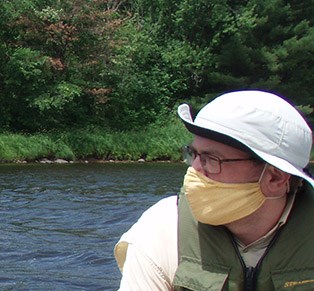
NPS/R. Damstra
The Only Constant is Change
It has been said that the only constant in life is change. Indeed, after bidding farewell and happy retirement to Tammy Keniry in April and sending Scientist-in-Parks intern Hallie Arno off to graduate school in July, we are doing the same now for four more of the network’s familiar faces.
Thomas Parr
Joining the NPS just months before the COVID-19 pandemic sent everyone home for two years was a challenge network program manager Thomas Parr confronted head-on. In late September, he moved on to new adventures as co-director of the Great Lakes Northern Forest Cooperative Ecosystem Studies Unit (CESU) in St. Paul, Minnesota.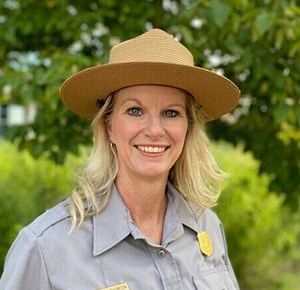
NPS photo
Carmen Thomson
Similarly, Carmen Thomson left the Inventory and Monitoring Division (IMD) in early September to become superintendent at Canaveral National Seashore in Florida. Coming to the IMD in 2005, Carmen spent the last 18 years as the Midwest Region I&M program manager based in Omaha.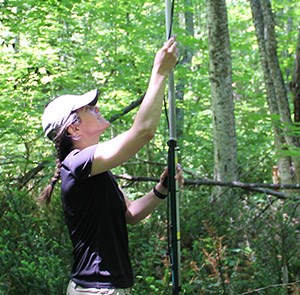
NPS photo
Katy Goodwin
Katy’s NPS career started in 2001 as a Volunteers-In-Parks intern at ISRO. She returned to the island in 2004 as a biological technician, a position she held for the next nine seasons. Katy began graduate work at North Dakota State University in 2017, concurrent with her being hired by the network as the bat monitoring coordinator. She finished her Master’s degree in 2019. Katy is leaving the NPS to work as a biologist with the USGS Forest and Rangeland Ecosystem Science Center, based in Bozeman, Montana.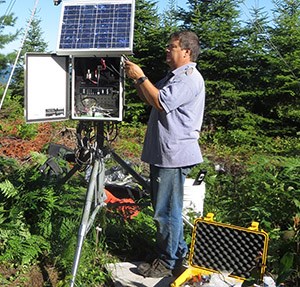
NPS/J. Van Stappen
Mark Hart
Network data manager Mark Hart retired at the end of August. His 20-year career began in 2003, when he was hired as a Data Specialist for the newly created Great Lakes Network and the Great Lakes Exotic Plant Management Team. He moved into the Data Manager position the following year. In addition to having a hand in data management for all of the network’s monitoring programs, he oversaw weather and climate monitoring, which included annual visits to remote weather stations in the parks. He assisted in managing the amphibians monitoring program when it began, and piloted an eDNA surveillance project to accompany the audio data being collected. He also provided data management assistance for park projects including the Isle Royale Wolf Reintroduction. Beyond the network, Mark served as the acting IMD Data Manager twice and participated in a number of division-level initiatives, including the creation of the Long-Term Data Management Plan. In retirement, Mark plans to travel and will continue cultivating grapes. Congratulations and best wishes, Mark!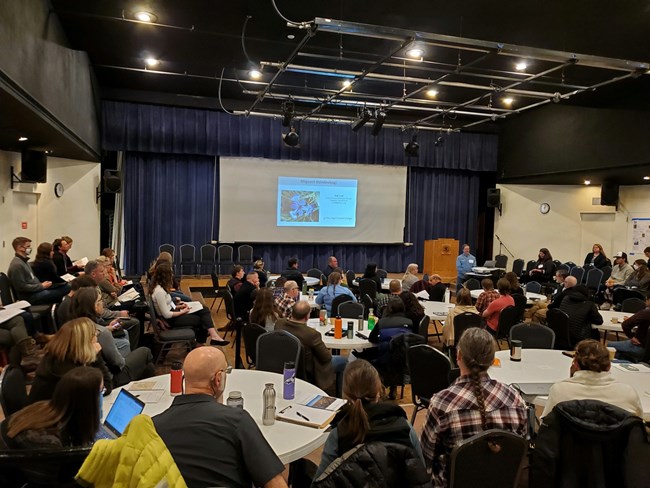
NPS photo.
Return of the Western Great Lakes Research Conference!
On 21 March, more than 158 registered participants packed into the Alvord Theater at Northland College for a three-day gathering that highlighted science and scholarship occurring across the western Great Lakes region.The Great Lakes Science for Parks Symposium was a forum for 44 presentations and 14 posters on topics ranging from the Great Lakes Indian Fish and Wildlife Commission’s climate change vulnerability assessment for upper Midwest Ceded Territories, to assisted migration of climate change-vulnerable tree species on the Superior National Forest, to a decade of archaeological surveys on Isle Royale. An added bonus to the symposium being hosted by and held on the campus of Northland College is that students were free to wander in and out of presentations, gaining exposure to science and resource management and having opportunities to interact with potential future employers.
This event was the reinvigoration of a formerly annual gathering of scientists and mangers that had not occurred since 2012. Historically, this conference was not merely a presentation of scientific results. It also served as a training forum for cultural and natural resource managers, as well as inspiring and coordinating projects among federal and non-federal scientists and managers. This simple meeting fostered an exceptionally strong and collaborative network of park cultural and natural resource managers and scientists.
The simplest way to encapsulate the impact this meeting has on many careers in the Great Lakes region is what one participant nearing retirement shared with us: It really means a lot to me to see this come back before I retired. That the return of a meeting return had held such a place in a manager’s career was humbling. It also begs the question of why? Why is this in-person meeting important when we have software like MS Teams? The answer is simple: humans are social. Virtual meetings work well to maintain strong connections that already exist and allow rapid exposure to a wide variety of ideas. However, in-person interactions create a deeper and more meaningful connection. These interactions form the foundations of professional networks that make people’s professional efforts and careers successful. Project by project these successes create impact and “move the needle” in ensuring public lands are there for the enjoyment of future generations.
Going forward, we envision a regular (every other year if not every year) meeting that fills this critical need for connection and professional network-building. Your enthusiasm for this meeting provided us with a lot of ideas to include in future conferences such as allowing more time for viewing posters and talking to those presenters, more structured after-hours social activities, an option for virtual attendance to some sessions, more participation of cultural resource managers, better inclusion of tribal partners, and perhaps skills-focused training sessions.
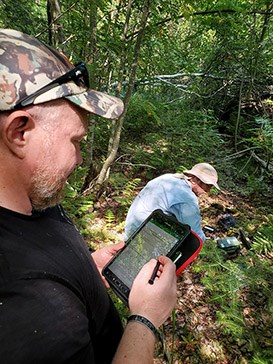
NPS/T. Gostomski
2023 Field Season Summary
Amphibians
Acoustic monitors were once again deployed in seven parks this year. In cooperation with our contractor, Great Lakes Ecological Services, we will perform manual identification of the data collected in 2023.We developed a digital data form to streamline field data collection, and we are working to finalize the amphibian monitoring database as an IRMA application.
Summary reports of 2019 data were completed for each participating park and are available on the network website (www.nps.gov/im/glkn/amphibians.htm). We will complete 2020 data summary reports over the coming winter.
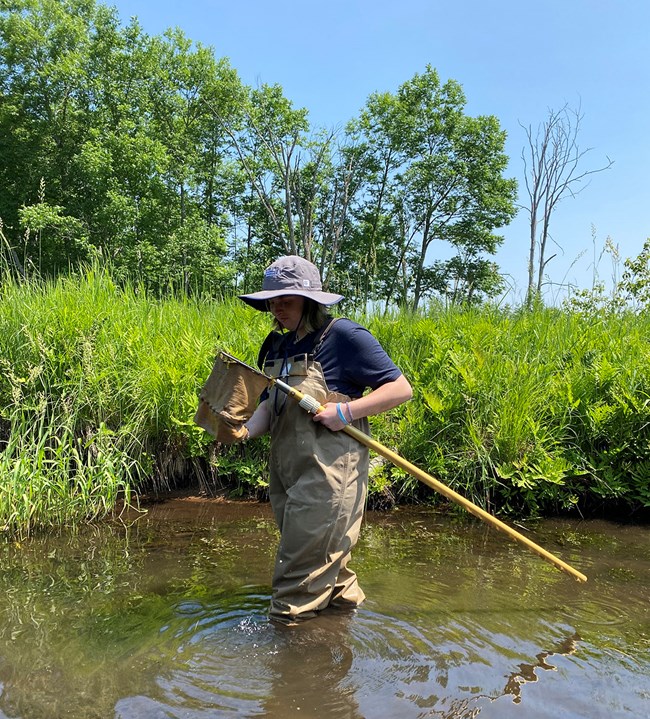
Photo by Valerie Damstra/Northland College
Contaminants
Dragonfly Larvae
In partnership with Northland College, park staff, and volunteers, dragonfly larvae were collected from all nine network parks in 2023. Erin Argyilan, the new Education Coordinator at the Great Lakes Research and Education Center, took over sampling dragonfly larvae at INDU.Samples were sent to a USGS lab in Oregon, where they will be analyzed for mercury. Also, most samples collected this summer will be analyzed for PFAS as part of a nationwide assessment of PFAS on National Park Service lands. PFAS, or per- and polyfluoroalkyl substances, are synthetic chemicals that repel water and oil and are used in a many products, including food packaging, non-stick cookware, and firefighting foam. PFAS are one of a group of substances referred to as “forever chemicals” because they take a long time to break down in the environment.
While presenting an overview of the dragonfly contaminants monitoring at the Great Lakes Science for Parks Symposium this spring, David VanderMeulen demonstrated the Dragonfly Mercury Project’s online data visualizer (www.nps.gov/articles/dragonflymercury-map.htm), where park and site-level status and trends are displayed. There is also a page that provides annually updated “dragonfliers” for each park that is participating in the monitoring program (https://geonarrative.usgs.gov/dragonflier/). Links to both of these pages can be found on our Contaminants monitoring web page (www.nps.gov/im/glkn/contaminants.htm).
Bald Eagles
Bald eagle nest productivity surveys occurred this spring at MISS and at APIS. Productivity is measured by counting the number of nests that contain bald eagle nestlings. At APIS, additional work was conducted by some of our partners at the Wisconsin DNR to collect blood and feather samples from eagle nestlings to test them for PFAS.Productivity at MISS was similar to recent years, while it was low at APIS, especially for island nests. This may have been the result of this year’s cold wet spring.
Landbirds
We really noticed the mosquitoes during bird surveys this year. During some point counts at Voyageurs, the constant buzzing close in around the head noticeably reduced the ability to hear singing birds.At Isle Royale, a Brown Thrasher and a flock of more than 29 Red Crossbills were observed in the burned-over area of the 2021 Horne Fire. Overall, Indigo Buntings, Blackburnian Warblers, and Canada Warblers had a good year, possibly due to the continuing outbreak of spruce budworm.
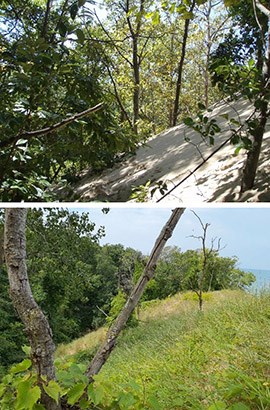
NPS photo.
Vegetation
The vegetation crew spent the summer of 2023 sampling the 47 permanent sampling sites at Indiana Dunes NP. This year marked the beginning of our third visit to our permanent sites at parks.Sampling at INDU is a welcome challenge for our permanent staff since we get to identify a whole new suite of southern species that we do not encounter in our northern parks. This makes for a few head scratches in the beginning of the season as we get our bearings with the different habitats.
While we have not yet done any analysis of this year’s data to look for specific changes, INDU is a dynamic and changing park. The active use of fire on the land at INDU is exciting to see up close. Previously open sampling sites are now thick with young tree saplings, while other sites are now open because they have experienced recent fire. In addition, successful wetland restoration projects at the park mean that wetlands are now encroaching on some of our forest sampling sites.
One interesting change was observed at a sampling site near Mt. Baldy, where forest is slowly being taken over by the dune, resulting in dead trees and an influx of dune stabilizing beach grass.

NPS
Water Quality—Inland Lakes
Pictured Rocks NL
Overall, PIRO lake levels were below average except for Chapel Lake, where they have increased over the last few years, peaking at a record high in June. High water levels made it possible to canoe down the outlet (Chapel Creek) to document the presence of a large beaver dam responsible for the backed-up water.In addition to our usual sampling, we also collected sediment samples for diatoms.
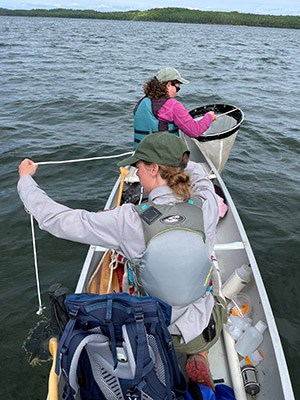
NPS/A. Egan
Isle Royale NP
At ISRO, we partnered with the University of Minnesota-Duluth to collect zooplankton from many of our sample lakes. That project is going to compare zooplankton communities with those collected during a study done a couple decades ago. We added Chickenbone Lake and Lake Whittlesey to that round of zooplankton sampling so that we can look for spiny water flea. Chickenbone and Whittlesey are “first contact” lakes for paddlers portaging from Lake Superior (McCargoe Cove and Chippewa Harbor, respectively), so they are vulnerable entry points for the spiny water flea, which we know is in Lake Superior.Alex joined the NPS Great Lakes Big Rivers Dive Team and assisted with zebra mussel surveys on docks and shallow reefs, along with one native mussel survey at Chippewa Harbor.
ISRO’s Lake Desor had a bad algae bloom by August, the worst we have ever seen in that lake. Nearly all of the ISRO lakes now have noticeable algae in the water column by August, probably due to a combination of changing weather patterns and inherent landscape conditions in the park.
Voyageurs NP
Sampling conditions at Voyageurs were typical of the north country. Early summer water levels were a bit higher than average in several lakes. Locator was notably below average all summer, and by August was more than 2 meters (6.5 feet) below our benchmark. In our deeper lakes (Mukooda, Little Trout, Locator, and Cruiser), a thermocline was well formed by the time sampling began in June. Our shallower lakes (Ek, Shoepack, Ryan, Peary, and Brown) were typically anoxic below about 4 meters (13 feet).Staff collected horizontal zooplankton tows in the littoral zone of several GLKN index lakes. Partnering with UMD we hope to determine zooplankton community vulnerability to spiny water flea. We hope to grow out our species list in these lakes by sampling nearshore areas that have not been well surveyed in the past.
Of note this year was the deafening numbers of biting flies and swarms of ticks. Biting insects are an expected part of working in wetlands on the Kabetogama peninsula, but this year was truly special. With historic flooding throughout the watershed in 2022 and a wet spring in 2023 there were sufficient densities of biting flies to cause a ringing in one staff member’s ears several hours after leaving the wetlands. Don’t even get me started on the ticks.
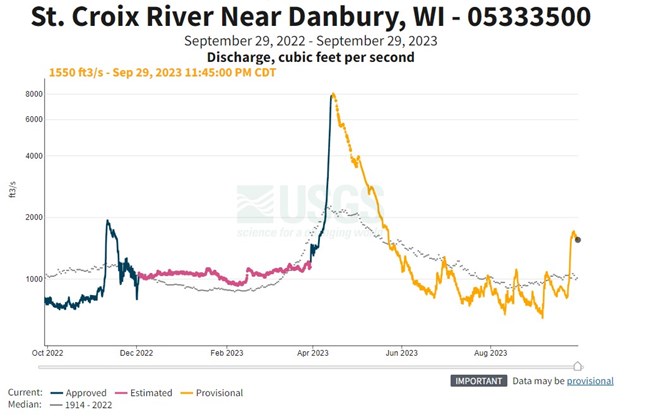
Graph from U.S. Geological Survey, Water Data for the Nation (https://waterdata.usgs.gov/monitoring-location/05333500/#parameterCode=00060&showMedian=true&startDT=2022-09-29&endDT=2023-09-29)
Water Quality—Large Rivers
April sampling was delayed a week due to late ice-out. Even after the rivers did open up, some sites were inaccessible due to deep snow covering boat launch access roads or floating ice created unsafe boating conditions.Water was very high in early May, but by June, river flow had dropped below the median and stayed low through September due to drought conditions most of the summer (see graph).
In addition to routine water quality sampling, we worked with SACN park staff to collect aquatic insect samples and test continuously deployed water quality sensors on the St. Croix and Namekagon Rivers. Sediment cores were also collected from soft bottoms at four sites for diatom analysis during late 2022 and early 2023.

NPS/C. Hester
Weather and Climate
Routine maintenance was performed this year on stations at Sand Island (APIS) and in Munising, Michigan (PIRO). The wind, temperature, humidity, barometric pressure, and fuel sensors are performing as expected for the Pictured Rocks station. The solar radiation sensor, however, is reporting gaps in its readings and will likely need to be replaced during the next maintenance visit.In the case of the Sand Island station, the fuel moisture and fuel temperature sensors continue to report anomalous readings, despite being completely replaced in August. We will solicit advice from the sensors’ manufacturer and from other weather station operators in hopes of resolving the issue.
High winds and waves canceled our trip to North Manitou Island (SLBE), so no maintenance was done on that station this year. Fortunately, few quality control triggers have been tripped at the North Manitou station, and it is expected to operate effectively until staff can perform a maintenance inspection next spring.

NPS/T. Gostomski
New Reports and Publications
All of these reports can be found on the Great Lakes Network website: www.nps.gov/im/glkn/reports-publications.htm. Those published in peer-reviewed journals can also be found using their DOI (digital object identifier). Great Lakes Network staff are indicated in bold text.Mallinger, E.C., K.R. Goodwin, A. Kirschbaum, Y. Shen, E.H. Gillam, and E.R. Olson. 2023. Species-specific responses to white-nose syndrome in the Great Lakes region. Ecology and Evolution. Available at: https://doi.org/10.1002/ece3.10267.
Goodwin, K.R., and A. Kirschbaum. 2023. Acoustic monitoring for bats at Pictured Rocks National Lakeshore: Data summary report for 2015–2018. Natural Resource Data Series NPS/GLKN/NRDS—2023/1397. National Park Service, Fort Collins, Colorado. Available at: https://doi.org/10.36967/2299944.
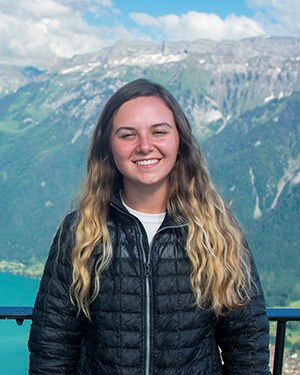
In other staff news...
Two network staff served in 120-day details in 2023. Senior Aquatic Ecologist David VanderMeulen served as a Project Manager for the Water Resources Division’s Natural Resource Condition Assessment Program from April through July. In that role, he reviewed NRCA proposals and technical reports, checked the status of ongoing projects, and helped push a few older projects over the finish line.In July, Ecologist Suzy Sanders packed her bags, put on a uniform(!), and headed to Katmai National Park and Preserve in King Salmon, Alaska, where she is serving as a Natural Resource Program Manager until early November.
In October, Cyrus Hester was promoted to Data Manager, replacing Mark Hart, who retired in August, and Joni Guenther arrived to replace Tammy Keniry (see below).
Kate Miller assumed the acting Network Program Manager role in late October. Kate is a Quantitative Ecologist for the Northeast Temperate and Mid-Atlantic Networks (NETN, MIDN). She’s been with the NPS since starting with NETN in 2006, and she is currently based in Acadia National Park in Maine. A graduate of Northland College here in Ashland, Kate comes to this detail already knowledgeable about the region and many of the network parks.
Kate Roberts began an internship with the network in October as a GIS Technician. She comes to Wisconsin from Tempe, Arizona, just as winter is coming on, but she says she’s “very excited to be living on frigid Lake Superior until April 2024” and she lists cross-country skiing as a favored pastime. Kate recently graduated from Arizona State University with a BS in Geographic Information Science.
“I am fascinated by the ways that math and physics can be used to model natural/anthropogenic phenomena,” she says.
As the GIS intern, she will assist the Landscape Dynamics program with validating vegetation disturbance data generated from LandTrendr.

Welcome, Joni Guenther!
Joni Guenther was hired as the network's Administrative Support Assistant, replacing Tammy Keniry, who retired in April. Joni started in October.Joni comes to the National Park Service with 19 years of Federal experience, 15 of those years working in administration for the Bureau of Indian Affairs and U.S. Forest Service. Joni is extremely excited to be working with this team and looks forward to sharing her knowledge and providing technical assistance.
Joni and her husband Mark have three children: Ireland, Gus and Iley.

Looking For Something?
We can help with that!The Great Lakes Network website has a page for every park— www.nps.gov/im/glkn/parks-partners.htm. That’s where you can find every report and resource brief we have ever written about you, along with web articles that can be linked to your park website. And the reports are not just ours. The list pulls from IRMA (https://irma.nps.gov/Portal/) every report with your park’s name on it. In some cases, there’s a record of the report but no digital file you can download. If you find one of those, chances are there’s a hard copy in a file drawer somewhere in your resource management office.
Explore the page and let us know if there is something you need that you are not finding. We can help!

Ted Gostomski
Network Program Manager
Kate Miller (acting)
Thanks to the following contributors: Rick Damstra, Valerie Damstra, Alex Egan, Joni Guenther, Cyrus Hester, Leah Kainulainen, Thomas Parr, Suzy Sanders, James Smith, David VanderMeulen.
Tags
- apostle islands national lakeshore
- grand portage national monument
- indiana dunes national park
- isle royale national park
- mississippi national river & recreation area
- pictured rocks national lakeshore
- saint croix national scenic riverway
- sleeping bear dunes national lakeshore
- voyageurs national park
- great lakes network
- newsletter
